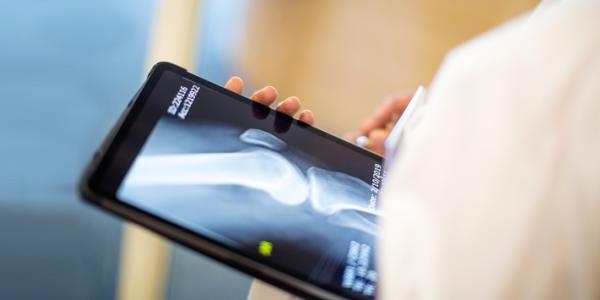
Technological innovations are changing the way we approach medicine. Let's take a look at robotic-assisted surgeries and examine the impact of cutting-edge orthopedic technologies.
With all of the advances in orthopedic surgery, positive outcomes have improved drastically over the years. One of the biggest innovations in orthopedics — and other surgical branches — is in robotic-assisted surgery, which allows doctors to perform several types of complex procedures with increased precision, flexibility and control. Conventional techniques, while successful, can benefit from a shared-control method that incorporates robotic assistance as needed. El Camino Health has been a leader in the field for over a decade, carrying out more than 15,000 procedures since we began offering robotic-assisted surgeries in 2006.
This cutting-edge technology opens the door to minimally invasive surgeries. The advantages of robotic surgeries can include fewer surgical complications, less pain and blood loss, quicker recovery and reduced scarring. While robotic surgeries involve risks, many of them are similar to those of conventional surgery; such as a minor risk of infection and other complications. As with any surgery, it comes down to being in the hands of experts — and at El Camino Health, we have spent nearly two decades perfecting our robotic-assisted surgical model.
Robotic-assisted surgery is used in several specialties, including gynecologic oncology, cardiothoracic, gastrointestinal, otolaryngology (head and neck) and urologic surgery. Each of these different practices uses distinct robotic assistance systems that are specifically designed for the surgeries being performed. While there are many more robotic systems in use with other specialties, El Camino Health has narrowed robotic assistance in orthopedics down to three interactive systems.
Mako® Robotic-Arm Assisted Joint Replacement: Our surgeons at El Camino Health use this approach for hip and knee replacements. The Mako® Robotic-Arm allows the surgeon to place the new joint with more accuracy and precision. The result is a more natural-feeling movement and improved recovery time.
ROSA® Knee System: The ROSA® Knee System uses innovative technology that gives our surgeons detailed, real-time insights into the specific anatomy and placement of your knee as they perform the surgery. With unparalleled accuracy, this system enhances efficacy for total knee replacement.
Mazor X Stealth™ Edition Robotic Guidance Platform: For spine cases, this technology allows our surgeons to implement a predictable, effective surgical plan with pinpoint accuracy. The Mazor X Stealth™ uses advanced guidance tools — including real-time, 3D imaging — to bring greater precision and foresight to each and every spinal surgery it accompanies.
If the idea of robotic-assisted surgery sounds a little unsettling, you should keep it mind that it's not new or experimental. In fact, the idea of robotic surgeries was posed more than 50 years ago and has been successfully implemented in the United States since 1992. Since then, robotic surgeries have overcome many limitations and reached a significantly lower mortality rate than non-robotic surgeries. On top of that, these technology-assisted surgeries broadly result in smaller incisions, reduced scarring, shorter procedures and faster recovery.
El Camino Health is committed to offering the latest, most promising technologies that are proven to enhance surgical efficacy, as well as the expertise to deliver exceptional results. If you are in need of an orthopedic surgery, a robotic-assisted procedure may be a good choice for you. Learn more about the latest innovations in orthopedic care at El Camino Health.
This article first appeared in the February 2022 edition of the HealthPerks newsletter and was updated in August 2023.

